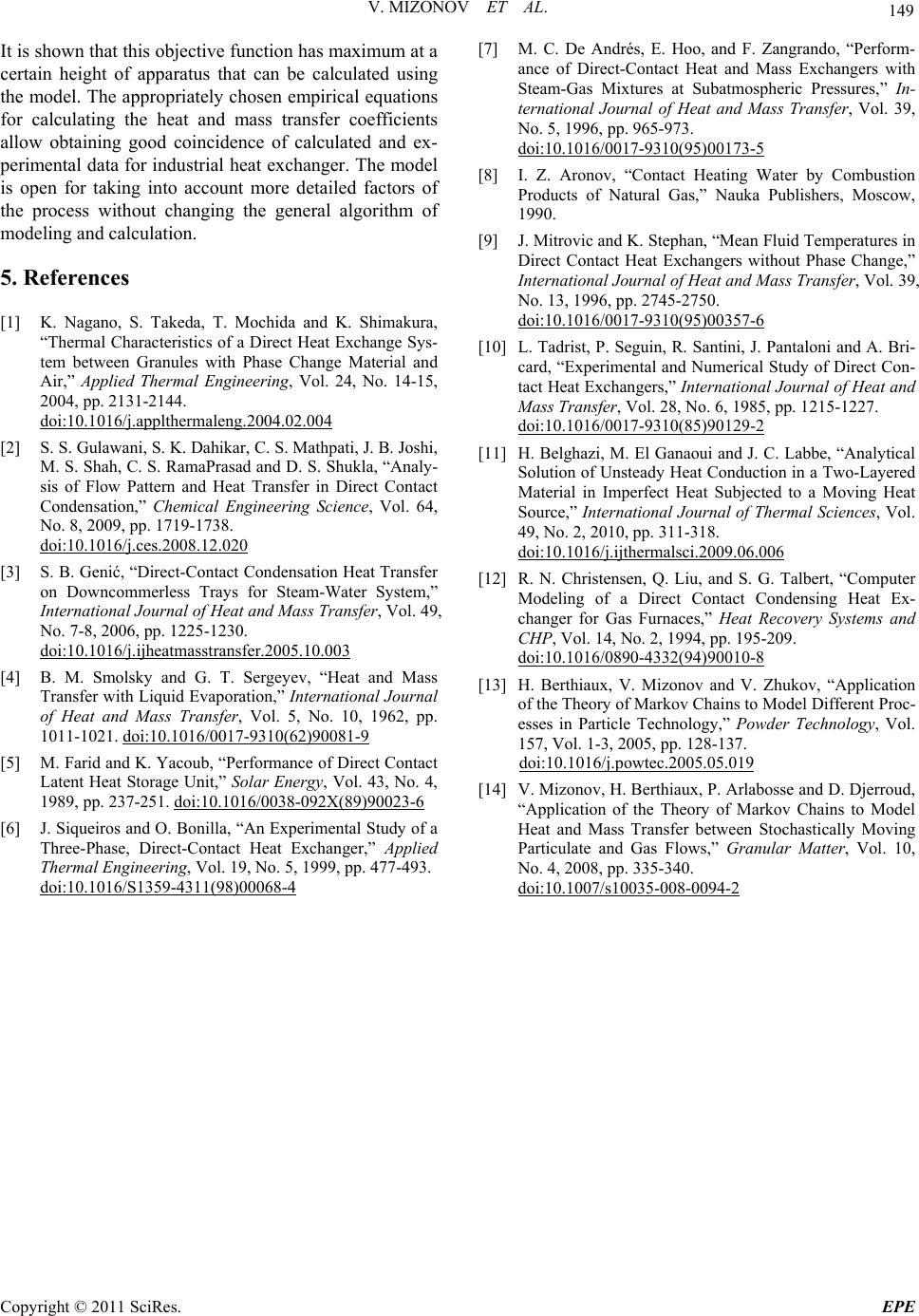
V. MIZONOV ET AL.
Copyright © 2011 SciRes. EPE
149
[7] M. C. De Andrés, E. Hoo, and F. Zangrando, “Perform-
ance of Direct-Contact Heat and Mass Exchangers with
Steam-Gas Mixtures at Subatmospheric Pressures,” In-
ternational Journal of Heat and Mass Transfer, Vol. 39,
No. 5, 1996, pp. 965-973.
doi:10.1016/0017-9310(95)00173-5
It is shown that this objective function has maximum at a
certain height of apparatus that can be calculated using
the model. The appropriately chosen empirical equations
for calculating the heat and mass transfer coefficients
allow obtaining good coincidence of calculated and ex-
perimental data for industrial heat exchanger. The model
is open for taking into account more detailed factors of
the process without changing the general algorithm of
modeling and calculation.
[8] I. Z. Aronov, “Contact Heating Water by Combustion
Products of Natural Gas,” Nauka Publishers, Moscow,
1990.
[9] J. Mitrovic and K. Stephan, “Mean Fluid Temperatures in
Direct Contact Heat Exchangers without Phase Change,”
International Journal of Heat and Mass Transfer, Vol. 39,
No. 13, 1996, pp. 2745-2750.
doi:10.1016/0017-9310(95)00357-6
5. References
[1] K. Nagano, S. Takeda, T. Mochida and K. Shimakura,
“Thermal Characteristics of a Direct Heat Exchange Sys-
tem between Granules with Phase Change Material and
Air,” Applied Thermal Engineering, Vol. 24, No. 14-15,
2004, pp. 2131-2144.
doi:10.1016/j.applthermaleng.2004.02.004
[10] L. Tadrist, P. Seguin, R. Santini, J. Pantaloni and A. Bri-
card, “Experimental and Numerical Study of Direct Con-
tact Heat Exchangers,” International Journal of Heat and
Mass Transfer, Vol. 28, No. 6, 1985, pp. 1215-1227.
doi:10.1016/0017-9310(85)90129-2
[2] S. S. Gulawani, S. K. Dahikar, C. S. Mathpati, J. B. Joshi,
M. S. Shah, C. S. RamaPrasad and D. S. Shukla, “Analy-
sis of Flow Pattern and Heat Transfer in Direct Contact
Condensation,” Chemical Engineering Science, Vol. 64,
No. 8, 2009, pp. 1719-1738.
doi:10.1016/j.ces.2008.12.020
[11] H. Belghazi, M. El Ganaoui and J. C. Labbe, “Analytical
Solution of Unsteady Heat Conduction in a Two-Layered
Material in Imperfect Heat Subjected to a Moving Heat
Source,” International Journal of Thermal Sciences, Vol.
49, No. 2, 2010, pp. 311-318.
doi:10.1016/j.ijthermalsci.2009.06.006
[3] S. B. Genić, “Direct-Contact Condensation Heat Transfer
on Downcommerless Trays for Steam-Water System,”
International Journal of Heat and Mass Transfer, Vol. 49,
No. 7-8, 2006, pp. 1225-1230.
doi:10.1016/j.ijheatmasstransfer.2005.10.003
[12] R. N. Christensen, Q. Liu, and S. G. Talbert, “Computer
Modeling of a Direct Contact Condensing Heat Ex-
changer for Gas Furnaces,” Heat Recovery Systems and
CHP, Vol. 14, No. 2, 1994, pp. 195-209.
doi:10.1016/0890-4332(94)90010-8
[4] B. M. Smolsky and G. T. Sergeyev, “Heat and Mass
Transfer with Liquid Evaporation,” International Journal
of Heat and Mass Transfer, Vol. 5, No. 10, 1962, pp.
1011-1021. doi:10.1016/0017-9310(62)90081-9
[13] H. Berthiaux, V. Mizonov and V. Zhukov, “Application
of the Theory of Markov Chains to Model Different Proc-
esses in Particle Technology,” Powder Technology, Vol.
157, Vol. 1-3, 2005, pp. 128-137.
doi:10.1016/j.powtec.2005.05.019
[5] M. Farid and K. Yacoub, “Performance of Direct Contact
Latent Heat Storage Unit,” Solar Energy, Vol. 43, No. 4,
1989, pp. 237-251. doi:10.1016/0038-092X(89)90023-6 [14] V. Mizonov, H. Berthiaux, P. Arlabosse and D. Djerroud,
“Application of the Theory of Markov Chains to Model
Heat and Mass Transfer between Stochastically Moving
Particulate and Gas Flows,” Granular Matter, Vol. 10,
No. 4, 2008, pp. 335-340.
doi:10.1007/s10035-008-0094-2
[6] J. Siqueiros and O. Bonilla, “An Experimental Study of a
Three-Phase, Direct-Contact Heat Exchanger,” Applied
Thermal Engineering, Vol. 19, No. 5, 1999, pp. 477-493.
doi:10.1016/S1359-4311(98)00068-4